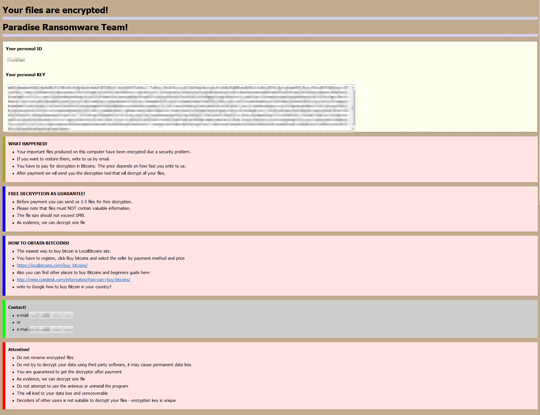RANSOM_PARADISE.G
Trojan-Ransom.Win32.Crypren.aede (KASPERSKY); Trojan.Gen.2 (NORTON); Mal/Randise-B (SOPHOS_LITE)
Windows


Threat Type: Ransomware
Destructiveness: No
Encrypted: No
In the wild: Yes
OVERVIEW
Dropped by other malware
This Ransomware arrives on a system as a file dropped by other malware or as a file downloaded unknowingly by users when visiting malicious sites.
It is capable of encrypting files in the affected system.
It encrypts files found in specific folders. It drops files as ransom note.
TECHNICAL DETAILS
36,864 bytes
EXE
Yes
11 Jan 2018
Drops files
Arrival Details
This Ransomware arrives on a system as a file dropped by other malware or as a file downloaded unknowingly by users when visiting malicious sites.
Installation
This Ransomware drops a copy of itself in the following folders using different file names:
- %Application Data%\DP\DP_Main.exe
(Note: %Application Data% is the Application Data folder, where it usually is C:\Documents and Settings\{user name}\Application Data on Windows 2000, Windows Server 2003, and Windows XP (32- and 64-bit); C:\Users\{user name}\AppData\Roaming on Windows Vista (32- and 64-bit), Windows 7 (32- and 64-bit), Windows 8 (32- and 64-bit), Windows 8.1 (32- and 64-bit), Windows Server 2008, and Windows Server 2012.)
It drops the following files:
- {malware path}\id.dp - contains encryption id
- %Desktop%\DecryptionInfo.auth - contains RSA key value
- %User Profile%\Documents\DecryptionInfo.auth - contains RSA key value
- %Program Files%\DP\DecryptionInfo.auth - contains RSA key value
(Note: %Desktop% is the desktop folder, where it usually is C:\Documents and Settings\{user name}\Desktop in Windows 2000, Windows Server 2003, and Windows XP (32- and 64-bit); C:\Users\{user name}\Desktop in Windows Vista (32- and 64-bit), Windows 7 (32- and 64-bit), Windows 8 (32- and 64-bit), Windows 8.1 (32- and 64-bit), Windows Server 2008, and Windows Server 2012.. %User Profile% is the current user's profile folder, which is usually C:\Documents and Settings\{user name} on Windows 2000, XP, and Server 2003, or C:\Users\{user name} on Windows Vista and 7.. %Program Files% is the Program Files folder, where it usually is C:\Program Files on all Windows operating system versions; C:\Program Files (x86) for 32-bit applications running on Windows 64-bit operating systems.)
Autostart Technique
This Ransomware adds the following registry entries to enable its automatic execution at every system startup:
HKLM\SOFTWARE\Microsoft\
Windows\CurrentVersion\Run
DP_Main = %Application Data%\DP\DP_Main.exe
Other Details
This Ransomware does the following:
- Executes the following command: "cmd.exe" /C sc delete VSS
- #Decrypt My Files#.html displays the following:

It is capable of encrypting files in the affected system.
Ransomware Routine
This Ransomware encrypts files found in the following folders:
- {Drive Letter}:\
- %Desktop%
(Note: %Desktop% is the desktop folder, where it usually is C:\Documents and Settings\{user name}\Desktop in Windows 2000, Windows Server 2003, and Windows XP (32- and 64-bit); C:\Users\{user name}\Desktop in Windows Vista (32- and 64-bit), Windows 7 (32- and 64-bit), Windows 8 (32- and 64-bit), Windows 8.1 (32- and 64-bit), Windows Server 2008, and Windows Server 2012.)
It avoids encrypting files with the following strings in their file path:
- Windows
- Firefox
- Chrome
- Opera
It avoids encrypting files found in the following folders:
- {malware path}
- %Application Data%\DP
(Note: %Application Data% is the Application Data folder, where it usually is C:\Documents and Settings\{user name}\Application Data on Windows 2000, Windows Server 2003, and Windows XP (32- and 64-bit); C:\Users\{user name}\AppData\Roaming on Windows Vista (32- and 64-bit), Windows 7 (32- and 64-bit), Windows 8 (32- and 64-bit), Windows 8.1 (32- and 64-bit), Windows Server 2008, and Windows Server 2012.)
It appends the following extension to the file name of the encrypted files:
- [id-{encryption id}].[paradise@all-ransomware.info].paradise
It drops the following file(s) as ransom note:
- {Encrypted file path}\#Decrypt My Files#.html
NOTES:
This ransomware connects to the URL localhost/api/Encrypted.php
It also sends the following information:
- vector
- encrypted file count
- computer name
- elapsed time of encryption
- decryption info
- encryption ID
SOLUTION
9.850
13.898.03
11 Jan 2018
13.899.00
12 Jan 2018
Step 1
Before doing any scans, Windows XP, Windows Vista, and Windows 7 users must disable System Restore to allow full scanning of their computers.
Step 2
Note that not all files, folders, and registry keys and entries are installed on your computer during this malware's/spyware's/grayware's execution. This may be due to incomplete installation or other operating system conditions. If you do not find the same files/folders/registry information, please proceed to the next step.
Step 3
Identify and terminate files detected as RANSOM_PARADISE.G
- Windows Task Manager may not display all running processes. In this case, please use a third-party process viewer, preferably Process Explorer, to terminate the malware/grayware/spyware file. You may download the said tool here.
- If the detected file is displayed in either Windows Task Manager or Process Explorer but you cannot delete it, restart your computer in safe mode. To do this, refer to this link for the complete steps.
- If the detected file is not displayed in either Windows Task Manager or Process Explorer, continue doing the next steps.
Step 4
Restart in Safe Mode
Step 5
Delete this registry value
Important: Editing the Windows Registry incorrectly can lead to irreversible system malfunction. Please do this step only if you know how or you can ask assistance from your system administrator. Else, check this Microsoft article first before modifying your computer's registry.
- In HKEY_LOCAL_MACHINE\SOFTWARE\Microsoft\Windows\CurrentVersion\Run
- DP_Main = %Application Data%\DP\DP_Main.exe
- DP_Main = %Application Data%\DP\DP_Main.exe
Step 6
Search and delete this file
- %Application Data%\DP\DP_Main.exe
- {malware path}\id.dp
- %Desktop%\DecryptionInfo.auth
- %User Profile%\Documents\DecryptionInfo.auth
- %Program Files%\DP\DecryptionInfo.auth
- {Encrypted file path}\#Decrypt My Files#.html
Step 7
Restart in normal mode and scan your computer with your Trend Micro product for files detected as RANSOM_PARADISE.G. If the detected files have already been cleaned, deleted, or quarantined by your Trend Micro product, no further step is required. You may opt to simply delete the quarantined files. Please check this Knowledge Base page for more information.
Step 8
Restore encrypted files from backup.
Did this description help? Tell us how we did.

